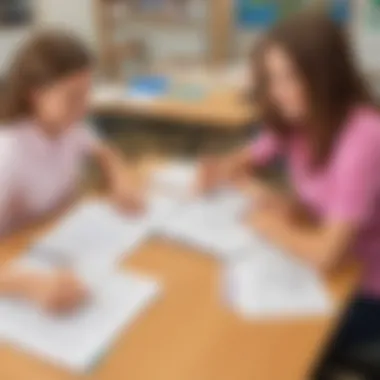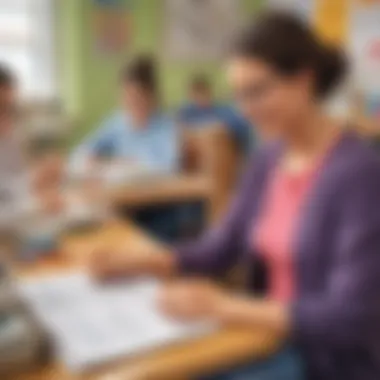Crafting Engaging Lesson Plans: A Comprehensive Guide for Teachers


Crafting Engaging Lesson Plans for Teachers
It is essential for educators to delve into the intricate process of crafting effective lesson plans to ensure optimal student engagement and educational success. By understanding the core components and structure required in lesson planning, teachers can elevate their teaching practices and deliver impactful learning experiences to their students.
Key Components of Lesson Planning
To begin with, developing a profound understanding of the key components involved in lesson planning is crucial. Teachers need to thoroughly analyze the curriculum requirements, educational objectives, and student needs before structuring their lessons. By aligning these aspects cohesively, educators can create a well-rounded learning experience that caters to the diverse needs of their students.
Importance of Engagement and Relevance
Engagement and relevance play a vital role in crafting effective lesson plans. Teachers must incorporate interactive elements, such as hands-on activities, group discussions, and multimedia resources, to captivate students' interests and boost their participation in the learning process. Moreover, relevance ensures that the content being taught is relatable to students' experiences and fosters a deeper connection to the material.
Planning for Diverse Learners
Taking into account the diverse learning styles and abilities present within a classroom is imperative. Teachers should integrate differentiated instruction strategies to accommodate various learning preferences and support students with individualized needs. By employing tailored approaches in lesson planning, educators can create inclusive and accessible learning environments that cater to every learner.
Utilizing Assessment Strategies
Incorporating assessment strategies within lesson planning enables teachers to gauge students' understanding and progress effectively. Formative assessments, such as quizzes, discussions, and feedback sessions, provide valuable insights into students' comprehension levels and inform instructional decisions. Additionally, summative assessments offer a comprehensive evaluation of students' overall learning outcomes and assist in refining future lesson plans.
Synthesizing Information for Effective Teaching
To conclude, synthesizing the information presented throughout the lesson planning process is key to enhancing teaching effectiveness. Reflecting on the learning objectives, student feedback, and outcomes of each lesson allows teachers to refine their instructional approaches continuously. By iteratively improving lesson plans based on insights gained from teaching experiences, educators can optimize their impact on students' learning journeys.
Introduction
Importance of Lesson Planning


Enhancing Student Engagement
Enhancing student engagement is a crucial element in lesson planning as it cultivates an active learning environment where students are motivated to participate. By incorporating interactive activities, real-life examples, and multimedia resources, teachers can capture students' attention and foster a deeper understanding of the subject matter. This approach not only enhances comprehension but also nurtures a passion for learning.
Meeting Curriculum Standards
Meeting curriculum standards is integral to lesson planning as it ensures that educational objectives are aligned with established guidelines. By adhering to these standards, teachers guarantee that their lessons cover the necessary content and skills stipulated by educational authorities. This adherence not only enhances the quality of education but also provides students with a well-rounded academic experience.
Facilitating Effective Teaching
Facilitating effective teaching through lesson planning involves designing strategies that cater to diverse learning styles and abilities. By incorporating various teaching methods, such as visual aids, hands-on activities, and group discussions, educators can accommodate the individual needs of their students and create a conducive learning environment. This adaptability fosters a more interactive and inclusive classroom setting, ultimately leading to enhanced learning outcomes.
Understanding Educational Objectives
Aligning with Learning Outcomes
Aligning lesson objectives with learning outcomes is essential in ensuring that students attain the necessary knowledge and skills. By structuring lessons around predetermined learning goals, teachers can track student progress and assess the effectiveness of their teaching methods. This alignment not only fosters academic growth but also provides a clear roadmap for achieving educational milestones.
Adapting to Student Needs
Adapting lesson plans to meet the diverse needs of students is a cornerstone of effective teaching. By recognizing and accommodating varying learning paces, styles, and preferences, educators can create a supportive and inclusive learning environment. This flexibility not only enhances student engagement but also promotes a sense of belonging and acceptance in the classroom.
Incorporating Differentiation
Incorporating differentiation in lesson planning involves tailoring instructional strategies to cater to individual student requirements. By providing varied activities, assessments, and resources, teachers can address the unique strengths and challenges of each student. This personalized approach not only maximizes student potential but also promotes a positive attitude towards learning.
Key Components of a Lesson Plan
Crafting an effective lesson plan is the cornerstone of successful teaching. The key components of a lesson plan play a crucial role in enhancing the learning experience for students and achieving educational objectives. In this article, we delve deep into the fundamental aspects that make up a well-structured lesson plan. From setting clear learning goals, defining measurable objectives, to linking them to educational standards, each element contributes significantly to the overall effectiveness of the lesson plan.


Learning Goals and Objectives
Setting Clear Learning Goals
Setting clear learning goals is like paving the way for a successful educational journey. These goals serve as beacons that guide both teachers and students towards a common destination. By clearly defining what students are expected to learn, educators can streamline their teaching approach and create a focused learning environment. Clear learning goals also help in assessing the progress and effectiveness of the teaching methods employed, making them a fundamental aspect of every lesson plan. While setting clear goals may seem like a standard practice, its impact on overall learning outcomes cannot be overstated.
Defining Measurable Objectives
Measurable objectives provide teachers with tangible milestones to evaluate student progress. By defining objectives that are specific, measurable, achievable, relevant, and time-bound (SMART), educators can gauge students' understanding and mastery of the subject matter. This approach not only enhances the assessment process but also allows for targeted interventions to support students who may require additional help. The beauty of measurable objectives lies in their ability to bring clarity and structure to the learning process, fostering a sense of achievement among students.
Linking Objectives to Standards
Linking learning objectives to educational standards ensures that lesson plans are aligned with the broader educational framework. By connecting these objectives to established benchmarks and guidelines, educators can ensure that their teaching remains relevant and up-to-date. This alignment also facilitates a seamless transition between different educational levels and enhances the overall coherence of the curriculum. Moreover, linking objectives to standards provides a clear roadmap for both teachers and students, setting clear expectations and fostering a conducive learning environment.
Each aspect of learning goals and objectives plays a pivotal role in shaping the effectiveness of a lesson plan. By incorporating these elements thoughtfully, educators can create dynamic and targeted teaching strategies that cater to the diverse needs of students.
Structuring the Lesson Plan
In the realm of educational pedagogy, structuring lesson plans stands as a pivotal element carrying the weight of successful teaching practices. Crafting an effective lesson plan entails meticulous planning and organization to deliver impactful learning experiences. This section dissects the significance of structuring the lesson plan within the context of educational enhancement, shedding light on its intrinsic value and practical applications.
Lesson Outline
Sequential Flow of Activities
Embarking on the journey of learning, the sequential flow of activities serves as the backbone of a well-structured lesson plan. This chronological arrangement of activities guides students through a logical progression of concepts, ensuring a cohesive learning experience. The fluidity provided by a seamless sequence aids in maintaining student engagement and comprehension, fostering an environment ripe for knowledge absorption. The distinct advantage of a sequential flow lies in its ability to scaffold learning, building upon prior knowledge while paving the way for new insights and discoveries.
Transition Points
Transition points within a lesson plan act as strategic junctures where shifts in focus or activities occur. These transitional moments serve to smoothly connect different segments of the lesson, facilitating seamless transitions for learners. By integrating well-placed transition points, educators can maintain student interest, manage time effectively, and enhance the overall flow of the lesson. The dexterity in handling transitions ensures a coherent and structured learning experience, preventing disjointed or confusing content delivery.


Timed Segments
The incorporation of timed segments adds a layer of strategic planning to the lesson structure, allocating specific durations to different activities or sections. This time-bound approach aids educators in optimizing the lesson plan's efficiency, ensuring adequate coverage of content within designated time frames. By implementing timed segments, teachers can strike a balance between content delivery and student engagement, promoting focused learning experiences. However, it is essential to carefully consider the pacing of timed segments to avoid rushing through key concepts or lingering excessively on certain topics, thereby maintaining a harmonious instructional tempo.
Adapting Lesson Plans
Flexibility in Teaching
Adjusting to Student Needs
Adjusting to Student Needs is a crucial element in the teacher's toolkit when it comes to crafting impactful lesson plans. This component emphasizes the significance of customizing teaching methods and content to meet the individual learning requirements of students. By accommodating diverse learning styles, adjusting pace, and providing additional support where necessary, educators can ensure that every student receives a tailored education that maximizes their learning potential. The key characteristic of Adjusting to Student Needs lies in its ability to promote inclusive education and create an equitable learning environment for all students. This adaptability is crucial in addressing student weaknesses, building on strengths, and fostering a positive and productive learning atmosphere. While adjusting to student needs may require extra effort and planning, the benefits of enhanced student comprehension and engagement outweigh any challenges that may arise.
Modifying Activities
When it comes to crafting effective lesson plans, Modifying Activities plays a pivotal role in keeping students actively engaged and motivated throughout the learning process. This aspect focuses on adapting activities, tasks, and assessments to align with student interests, abilities, and goals. By tailoring activities to suit the diverse needs of learners, educators can create a dynamic and interactive learning environment that promotes deeper understanding and knowledge retention. The uniqueness of Modifying Activities lies in its ability to cater to various learning styles and preferences, ensuring that all students can participate meaningfully in the lesson. While there may be challenges in modifying activities to suit individual student requirements, the advantages of increased student participation and comprehension make it a worthwhile endeavor in the realm of crafting effective lesson plans.
Alternative Teaching Approaches
In the landscape of crafting effective lesson plans, Alternative Teaching Approaches offer educators a fresh perspective on engaging students and promoting deeper learning. This element highlights the importance of incorporating innovative and unconventional teaching methods to capture student interest and enhance understanding. By leveraging alternative teaching approaches such as project-based learning, flipped classrooms, or experiential learning, teachers can create a dynamic and enriching educational experience for their students. The key feature of Alternative Teaching Approaches is their ability to foster creativity, critical thinking, and real-world application of knowledge, transcending traditional teaching boundaries. While implementing alternative teaching approaches may require additional planning and resources, the advantages of increased student motivation, creativity, and long-term retention of information make them a compelling choice in the context of crafting effective lesson plans.
Conclusion
Summary of Lesson Planning
Effective Teaching Practices
Effective Teaching Practices play a pivotal role in shaping the educational experience for students. By incorporating research-based methods and innovative approaches, teachers can enhance student engagement and promote a deeper understanding of the subject matter. The primary characteristic of Effective Teaching Practices lies in their ability to adapt to varied learning styles, ensuring that all students have equal opportunities to succeed. This approach fosters a dynamic and interactive learning environment that nurtures critical thinking and problem-solving skills, making it a popular choice among educators seeking to optimize student learning outcomes.
Student-Centered Approach
The Student-Centered Approach revolutionizes traditional teaching methods by placing students at the center of the learning process. This approach prioritizes individualized learning experiences, allowing students to pursue topics that resonate with their interests and learning styles. By empowering students to take ownership of their education, the Student-Centered Approach cultivates a sense of autonomy and responsibility in learners, leading to increased motivation and enthusiasm towards learning. While the Student-Centered Approach requires careful planning and facilitation, its emphasis on student autonomy and agency makes it a valuable tool for fostering independent thinking and lifelong learning.
Continuous Learning Journey
The Continuous Learning Journey encapsulates the idea of education as a lifelong pursuit. By promoting a growth mindset and a commitment to continuous improvement, this approach encourages educators to reflect on their practices, identify areas for development, and engage in ongoing professional growth. The key characteristic of the Continuous Learning Journey is its emphasis on self-reflection and iterative improvement, empowering teachers to refine their teaching strategies and enhance student learning outcomes. While embarking on a Continuous Learning Journey requires dedication and perseverance, its long-term benefits in terms of professional development and pedagogical excellence make it a valuable investment for educators dedicated to continuous improvement.







